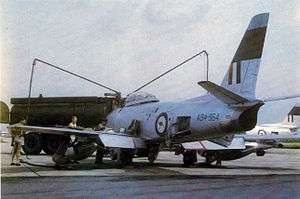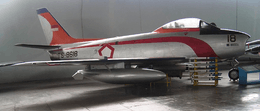CAC Sabre
| CAC Sabre | |
|---|---|
 | |
| CAC CA-27 Sabre, c. 1953 | |
| Role | Fighter aircraft |
| National origin | United States / Australia |
| Manufacturer | Commonwealth Aircraft Corporation |
| First flight | 3 August 1953 |
| Introduction | 1954 |
| Retired | 1971 (Royal Australian Air Force) 1982 (Indonesian Air Force) |
| Status | Retired, 1 active as a warbird |
| Primary users | Royal Australian Air Force Indonesian Air Force Royal Malaysian Air Force |
| Produced | 1953-61 |
| Number built | 112 |
| Developed from | North American F-86 Sabre |
The CAC Sabre, sometimes known as the Avon Sabre or CA-27, is an Australian variant of the North American Aviation F-86F Sabre fighter aircraft. The F-86F was redesigned and built by the Commonwealth Aircraft Corporation (CAC). Equipping five RAAF squadrons, the type saw action in the Malayan Emergency in the late 1950s, and was employed for air defence in Malaysia and Thailand in the 1960s. Ex-RAAF models also saw service with the Royal Malaysian Air Force and the Indonesian Air Force.
Development
In 1951, CAC obtained a licence agreement to build the F-86. It was decided to power the aircraft using a licence-built version of the Rolls-Royce Avon R.A.7. This involved a re-design of the fuselage as the Avon was shorter, wider and lighter than the General Electric J47 that powered the North American-built aircraft. Because of the engine change the type is often referred to as the Avon Sabre. To accommodate the Avon, over 60 percent of the fuselage was redesigned along with a 25 percent increase in the size of the air intake. Another major revision was in replacing the F-86F's six machine guns with two 30mm ADEN cannon,[1] while other changes were also made to the cockpit and to provide an increased fuel capacity.[2]
The prototype aircraft (designated CA-26 Sabre) first flew on 3 August 1953. The production aircraft were designated the CA-27 Sabre and first deliveries to the Royal Australian Air Force began in 1954. The first batch of aircraft were powered by the Avon 20 engine and were designated the Sabre Mk 30. Between 1957 and 1958 this batch had the wing slats removed and were redesignated Sabre Mk 31. These Sabres were supplemented by 20 new-build aircraft. The last batch of aircraft were designated Sabre Mk 32 and used the Avon 26 engine, of which 69 were built up to 1961.[1]
Operational history

_CAC_Sabre_Mk.32_landing_at_Avalon_during_the_2015_Australian_International_Airshow.jpg)

The RAAF operated the CA-27 from 1954 to 1971. The Aircraft Research and Development Unit received the first example in August 1954; it was delivered to No. 2 (Fighter) Operational Training Unit (subsequently No. 2 Operational Conversion Unit) in November. Over the next six years the Sabres progressively equipped Nos. 75, 3, 77 and 76 Squadrons.[2]
From 1958 to 1960, CAC Sabres of No. 78 Wing, comprising Nos. 3 and 77 Squadrons, undertook several ground attack sorties against communist insurgents in Malaya, during the Malayan Emergency. Following the Emergency, they remained in Malaysia at RAAF Butterworth.[3] Armed with Sidewinder missiles, the Sabres were responsible for regional air defence during the Konfrontasi between Indonesia and Malaysia from 1963 until 1966, though no combat took place.[4] Between October and December 1965, a detachment of six Sabres, initially from No. 77 Squadron and later from No. 3 Squadron, was based at Labuan to conduct combat patrols over the Indonesian–Malaysian border on Borneo.[5]
In 1962, a detachment of eight CAC Sabres, which was later expanded and designated No. 79 Squadron, was sent from Butterworth to RAAF Ubon, Thailand, to assist the Thai and Laotian governments in actions against communist insurgents. Australia and Thailand were allies of South Vietnam and the United States during the Vietnam War; No. 79 Squadron was responsible for local air defence at Ubon, where United States Air Force attack and bomber aircraft were based. The squadron never engaged North Vietnamese aircraft or ground forces.[6][7] Two Sabres were lost to engine failure in Thailand, in September 1964 and January 1968. No. 79 Squadron ceased operations and was deactivated in July 1968.[8]
The RAAF began re-equipping with the Dassault Mirage III in 1964.[9] The last Sabres in Australian service, operated by No. 5 Operational Training Unit, were retired in July 1971.[10]
Former RAAF CAC Sabres were operated by No. 11 Squadron of the Royal Malaysian Air Force (TUDM) between 1969 and 1972. Following the establishment of better relations with Indonesia, 23 CAC Sabres were donated to the Indonesian Air Force (TNI-AU) between 1973 and 1975, and operated by No. 14 Squadron; five of these were former Malaysian aircraft.[1]
In Australia one aircraft, RAAF-owned Sabre A94-983, has been restored to flying condition, and takes part in displays at the Temora Aviation Museum, New South Wales.[11]
Variants
- CA-26 Sabre
- Prototype, one built.[2]
- CA-27 Sabre Mk 30
- Production version powered by the Avon 20 engine and fitted with leading-edge slats; 22 built.[2]
- CA-27 Sabre Mk 31
- Version similar to Mk 30 but with an extended leading edge; 20 built and surviving Mk 30s converted to this standard.[2]
- CA-27 Sabre Mk 32
- Final production batch with underwing pylons and Avon 26 engine; 69 built.[2]
Operators
- Indonesian Air Force
- No. 14 Squadron
- Royal Malaysian Air Force
- No. 11 Squadron
Preserved aircraft
Specifications (Mk 32)
Data from Meteor, Sabre and Mirage in Australian Service[12]
General characteristics
- Crew: 1
- Length: 37 ft 6 in (11.43 m)
- Wingspan: 37 ft 1 in (11.3 m)
- Height: 14 ft 5 in (4.39 m)
- Wing area: 302.3 sq ft (28.1 m²)
- Empty weight: 12,000 lb (5,443 kg)
- Loaded weight: 16,000 lb (7,256 kg)
- Max. takeoff weight: 21,210 lb (9,621 kg)
- Powerplant: 1 × Rolls-Royce Avon turbojet, 7,500 lbf (33.4 kN)
Performance
- Maximum speed: 700 mph (1,100 km/h) (605 knots)
- Range: 1,153 mi, (1,000 NM, 1,850 km)
- Service ceiling: 52,000 ft (15,850 m)
- Rate of climb: 12,000 ft/min at sea level (61 m/s)
Armament
- Guns: 2× 30 mm ADEN cannons with 150 rounds per gun
- Rockets: 24× Hispano SURA R80 80mm rockets
- Missiles: 2× AIM-9 Sidewinder Air-to-air missiles
- Bombs: 5,300 lb (2,400 kg) of payload on four external hardpoints, bombs are usually mounted on outer two pylons as the inner pairs are wet-plumbed pylons for 2× 200 gallons drop tanks to give the CAC Sabre a useful range. A wide variety of bombs can be carried with maximum standard loadout being 2 x 1,000 lb bombs plus 2 drop tanks.
See also
- Related development
- Aircraft of comparable role, configuration and era
- Dassault Mystère IV
- de Havilland Venom
- Hawker Hunter
- Mikoyan-Gurevich MiG-17
- Republic F-84F Thunderstreak
- Saab 32 Lansen
- Sukhoi Su-9
References
Notes
- 1 2 3 Farquhar, Rod. "Avon Sabre in RAAF service and beyond" (PDF). ADF Serials. Retrieved 16 May 2013.
- 1 2 3 4 5 6 "CAC Sabre". RAAF Aircraft. RAAF Museum. Retrieved 28 June 2013.
- ↑ Stephens, Going Solo, pp. 252, 259–260
- ↑ Stephens, The Royal Australian Air Force, pp. 251–252
- ↑ "RAAF Sabres began Borneo patrols". Air Power Development Centre. Retrieved 1 May 2013.
- ↑ Stephens, Going Solo, pp. 272–273
- ↑ Eather, Flying Squadrons of the Australian Defence Force, p. 93
- ↑ RAAF Historical Section, Fighter Units, p. 73
- ↑ Stephens, Going Solo, p. 358
- ↑ "Final operations for RAAF Sabres". Australian War Memorial. Retrieved 28 June 2013.
- ↑ "RAAF CA-27 Sabre". Temora Aviation Museum. Retrieved 28 June 2013.
- ↑ Wilson, Meteor, Sabre and Mirage in Australian Service, p. 66
Bibliography
- Eather, Steve (1995). Flying Squadrons of the Australian Defence Force. Weston Creek, Australian Capital Territory: Aerospace Publications. ISBN 1-875671-15-3.
- RAAF Historical Section (1995). Units of the Royal Australian Air Force: A Concise History. Volume 2: Fighter Units. Canberra: Australian Government Publishing Service. ISBN 0-644-42794-9.
- Stephens, Alan (1995). Going Solo: The Royal Australian Air Force 1946–1971. Canberra: Australian Government Publishing Service. ISBN 0644428031.
- Stephens, Alan (2006) [2001]. The Royal Australian Air Force: A History. London: Oxford University Press. ISBN 0195555414.
- Wilson, Stewart (1989). Meteor, Sabre and Mirage in Australian Service. Fyshwick, Australian Capital Territory: Aerospace Publications. ISBN 0-9587978-2-X.
External links
| Wikimedia Commons has media related to CAC Sabre. |
- Australian National Aviation Museum – CA-27 Sabre A94–989 on display
- "The Avon-Sabre" – 1954 Flight article
- Details of Sabres in Indonesian service
- Details of Sabres in Malaysian service
| ||||||||||